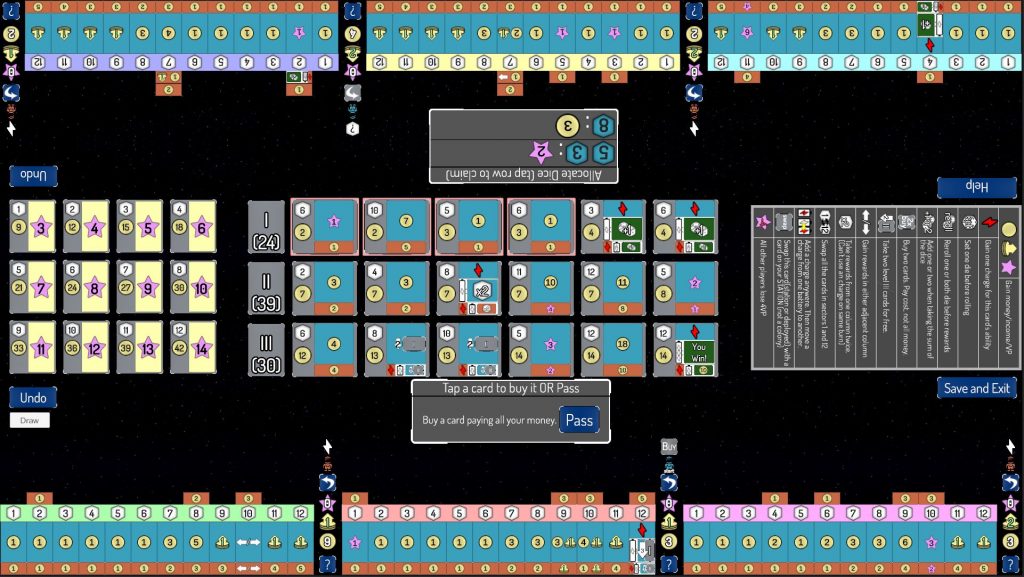I’ve finished converting Space Base for the touch table. Space base is a fairly quick card drafting game where you buy cards to fill in 12 columns. Each turn two die are rolled and you can take rewards from either both die or the sum of the dice. Cards give money, income, victory points and some have more complex abilities that need to be charged before use.

Our group started playing this game at the beginning of the year and we’ve been surprised both by how much we’ve played it and that we are still enjoying it. The game has a fair amount of setup and piece moving so it is a good candidate for conversion. Converting it also allows it to play six players.
We have a couple house rules that I implemented as options in the game. The first is to make the game more interesting for more players. It seems like the “right” number of players is three. That means that players can add a card to their board every third roll. With four, five, and six players, I feel like I don’t have enough control and the “active” card powers are very weak. So we have an option for multiple players to be active and buy. In a four player game, we allow two players to use their active powers and buy and in a six player we allow either two or three.
The other house rule is a simplification of the game for kids. In this mode, all cards with abilities that need to be charged are removed.
There were a couple things that made the game difficult to convert. One was fitting all the cards onto the screen. For a six player game, I need to display 36 cards along the long edge of the screen. This means that each card gets 100 pixels. A lot of the cards have abilities spelled out in text and when I put that text into a 100 pixel card, it was too small to read. So I needed to create iconography for all of the abilities. I think that the icons and graphics came out pretty well. Players that already know the game like the icons better than the text. I haven’t had new players learn the game on the touch table yet, so hopefully it isn’t too confusing to them. The icons, and particularly the charge counters are still pretty small and can be hard to see on a standard monitor
The other difficulty for this game was making sure that all the players could take their rewards at the same time. This is how it works in the physical game (you just have to trust the other players to do it right) and I didn’t want the touch table version to slow that down. There are very rare situations where the order that the players perform actions matters and the computer version leaves it up to the players to act in the correct order in those cases. Normally I like to have the computer enforce all the rules, but I didn’t want to cause delays for something that happens less than once in five games.
I tried to use a new animation system for this game. My idea was to have a separate thread that does animations and the main event thread that is doing model updates would add animations to the animation thread. This worked great until I needed multiple animations running at the same time. When I ran into that problem (which is pretty common in this game since all the players can act at once), I backed out my new animation thread code and have the main thread kick off each animation in its own little thread.
There are a few problems with this system. The worst is that I still have timing issues caused by two events creating conflicting animations. I’ve reduced this issue by making the animations as small as possible, but it still caused problems during development. The other issue is that by combining animation code and model update code I’ve made all the code a little more complex.
I’m not sure what I’ll try for animation in my next project. If the game is linear (one player acts at a time), I’ll probably give the animation thread another try. But if it is more like this game I’ll probably just use this system again.
This game took 64 hours to create. I took a shortcut on the graphics and re-used a lot of my work from Galaxy Trucker. I spent more time testing this game, but the actual implementation went surprisingly smoothly.